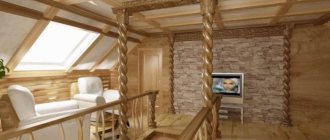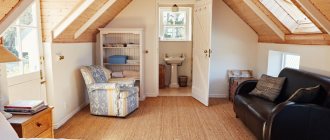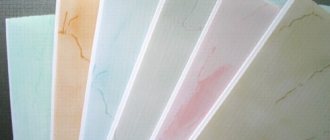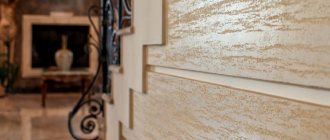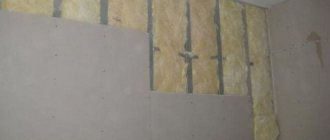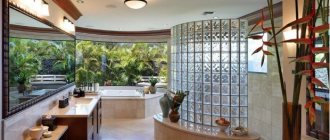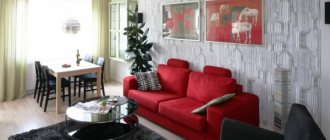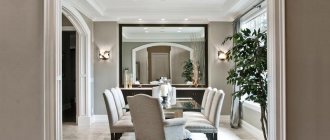Ordering complex balcony finishing from specialists will be quite expensive, so many home owners decide to do all the work themselves. At the initial stage, it is necessary to develop a project and wisely select finishing materials, consider the location of sockets and switches. The loggia can be turned into a comfortable place to relax, and if there is not enough space in the apartment, it can be used as a utility room for drying clothes and storing various accessories. In this article we will look at what to consider when choosing materials. Here you will also find step-by-step instructions on how to decorate a balcony with your own hands.
Balcony finishing options
Finishing the inside of a balcony with your own hands involves, first of all, a competent choice of materials and comprehensive insulation of the structure. It is noteworthy that it is not difficult to do such work on your own, even without the relevant experience.
By the way, if you want to insulate a balcony or loggia, then use the insulation instructions, a guide in 6 stages. There is also a large selection of facade finishing options here.
The most popular materials for interior cladding of balconies include:
- lining made of wood or plastic;
- PVC panels;
- laminate;
- MDF sheets;
- other materials.
The interior decoration of the balcony with wooden paneling allows you to end up with a stylish and cozy space for relaxation. This is an environmentally safe material, excellent for durable cladding. The advantages of lining include the ease of working with it, as well as wide possibilities for decoration by painting or highlighting the texture of natural wood.
The disadvantages of the material rightly include its ability to collapse under the influence of external factors. To protect wood, it is necessary to use special impregnating compounds.
Economical and durable options for finishing balconies include plastic panels. They are durable, resistant to moisture and ultraviolet radiation, and safe for health. Finishing the balcony with plastic panels allows you to hide serious defects in the surface of the walls and ceiling.
Often, chipboards are used to decorate a loggia or balcony. MDF has all the advantages of wooden lining, serves as an excellent means of heat and sound insulation, and has a budget price. The disadvantage of this decor is its relative fragility due to the low density of the panels. They do not tolerate mechanical stress well and quickly collapse under heavy load.
You should know that the electrical wiring in this case must be placed in a corrugated pipe for safety. MDF panels have a spectacular appearance, which allows you to create an original interior. It is easy to verify this by studying the photo of finishing the inside of the balcony using these materials.
Main conclusions
We talked to you about the best way to cover the inside of a loggia or balcony, as well as what materials should be given preference.
In the list of materials for sheathing, I did not mention laminated MDF panels. The material is affordable and of good quality, but does not like high humidity. This can cause it to swell and bulge. But this is the case when the panels actually become damp for some reason. Well, for example, when the window frames are not installed very well and when it rains, water gets inside.
If this is unlikely to happen, then it is quite possible to use such material.
I wish you the right choice and excellent results!
Best regards, Alexander Tkachenko.
Decoration Materials
Even if the balcony is planned to be used for storing some things and drying laundry, it must be dry, warm, and have an aesthetic appearance. A competent choice of materials for finishing the balcony inside and carrying out the necessary insulation and landscaping work will help solve this problem.
When choosing insulation and balcony covering options, it is important to take into account several important factors. These include the type of building, the quality of the wall surface, the design and the final functional purpose of the balcony.
Note!
Laying quartz vinyl tiles with your own hands step by step: instructions, subtleties, methods, features, installation, “Click-Drop”
Suspended ceiling Armstrong (125 photos): device, plate sizes, types, installation, calculation and installation
Textured paint for walls: types, how to apply it yourself, instructions, composition, varieties, photos of new designs
It is recommended to use moisture-resistant plasterboard slabs where it is necessary to hide old walls with an uneven surface. The slabs are perfect as a basis for further decorative finishing.
Working with this material is simple; the slabs are attached using the dry method to a pre-prepared sheathing. The result is a smooth surface that requires virtually no finishing. It is easy to cover the slabs with a textured decorative film or paint them.
When planning to use a balcony as an additional living space, it must be properly insulated. The following are most often used for this:
- mineral wool;
- penofol;
- Styrofoam.
Building materials used for finishing balconies and loggias inside must meet certain technical requirements. In particular, they must be:
- safe for human health and pets;
- have a low thermal conductivity;
- be resistant to moisture and sun rays;
- have a long service life without loss of basic consumer qualities.
Interior design experts recommend decorating loggias and balconies in natural colors. It is appropriate to use dark shades for floor coverings, and walls are often decorated with materials that can reflect the rays of the sun.
Note!
- Choosing a heated floor: water, infrared, film, rod, cable, resistive, self-regulating, pros and cons + instructions
Kitchen renovation in Khrushchev (155 real photos): new designs, layout options, furniture placement and zoning of a small kitchen
Decorative plaster: types for interior wall decoration, design photos, instructions for application and combination in the interior
Where to start insulating a loggia?
You should start, of course, with planning. You should decide on the functional purpose of this small room. If you plan to use it as a warehouse for things that are not very necessary, then insulation does not make much sense. But the loggia can be turned into an office, a small gym, a winter garden, etc.
There are also restrictions. For example, a loggia cannot be used as a kitchen space, i.e. install a stove, a sink for washing dishes, etc. It is also prohibited to install a centralized heating system in this area.
There are a number of other restrictions that may be related to the architectural features and fire safety of the building. This may be a ban on glazing above a certain floor, on changing the appearance of the building, the height of the fence, etc.
As practice shows, many manage to somehow circumvent these standards and arrange a loggia to their liking. Before starting work, it doesn’t hurt to coordinate your plans with supervisory authorities or prepare for problems to arise after the rework is completed.
Installation of electrical wiring, lighting and heated floors during insulation of the loggia must be thought out in advance so that damage to the heat-insulating material is minimal
But under no circumstances should openings be made in a load-bearing wall; only the openings provided for in the original design are permissible. Even a window and door unit removed from the loggia can pose a danger.
To keep the loggia warm, you will need high-quality glazing. It is better to order it from a reliable company. Double-glazed windows will do the job perfectly.
Part of the space will be “eaten up” by a layer of insulation. These centimeters will have to be sacrificed in order to reliably protect the house from the cold. Loggias located on the lower floors are most often insulated from the outside. We wrote about the best materials for external wall insulation here.
From the very beginning, you need to consider options for heating this space.
There are not so many of them, because only suitable for a loggia:
- electric TP;
- infrared TP;
- portable heater.
Considering that the installation area is small, you can spend money on such convenience as a TP. Cable systems are easy to install; you can do all the work yourself. Infrared flooring is more difficult to install; it requires an almost perfectly level base, but the cost of electricity during operation will be moderate.
But the simplest solution would be to use a heater, especially if the loggia is not used every day, but only from time to time. Installing heated floors will require more expense and effort.
Work order
Major repairs of a balcony or loggia require a certain sequence of work.
Their list includes:
- preparation of floor, wall and ceiling surfaces;
- insulation;
- wall and ceiling cladding;
- flooring;
- decorative design.
As a result, not only does the appearance of the balcony improve, but also its technical performance in terms of temperature and air humidity improves.
More detailed finishing work depends on the degree of insulation and the type of materials chosen. Many design options will require the construction of a base frame, and floor repairs require a base made of durable timber.
Causes of condensation
Condensation is the transition of a substance from a gaseous to a liquid state. In this case, we are talking about water vapor, which is always present in the air in one quantity or another. At a certain ratio of air humidity and temperature (when it decreases), condensation occurs in the form of dew drops. The higher the humidity, the higher the dew point.
When a balcony is glazed for the purpose of insulating it, especially with the help of metal-plastic windows, the ventilation of this room is disrupted, which can lead to an increase in humidity.
Additional factors may include drying laundry or placing flowers that are watered regularly. During the cold season, surfaces in contact with the street cool down. Water droplets form at the interface between moist air and cold surface. As a rule, dew forms on glass, external walls or ceilings.
Eurolining and lining
These are the most traditional materials for decorating the interior space of a balcony or loggia. Lining and eurolining are materials that are safe for health and easy to work with. The design features of wooden elements make it possible to ultimately obtain an almost seamless surface. Eurolining is equipped with additional channels for natural ventilation, which allows you to extend the life of the material.
The natural texture of natural wood allows you to get a pleasant and cozy interior. The owner independently decides how to sheathe the inside of the balcony. Finishing details are easy to place both horizontally and vertically. In this case, it is imperative to prepare a sheathing made of a metal profile or wooden beam. The guide battens are placed perpendicular to the sheathing parts.
Note!
How to update the tiles in the bathroom without changing them or removing them: step-by-step instructions, stickers, painting, decor (140 photos)
Do-it-yourself Venetian plaster walls: types, application instructions, photos of beautiful wall decoration, colors
How to unclog a toilet if it’s clogged: step-by-step instructions, a review of the most effective methods for removing a blockage with your own hands
If desired, it is easy to pre-insulate the room.
Wooden lining, like its more advanced analogue, must be treated with protective solutions against rot, mold, and also with a fire retardant. After drying, the finishing elements are sequentially attached to the sheathing, carefully aligning with each other at the seams.
The finishing touch will be varnishing or painting. This is necessary not only to give a more aesthetic appearance, but also to protect against moisture, dust and fungus.
Insulation on the ceiling
Insulation with penoplex on the ceiling differs from the process of laying on walls only in the need for additional fastening of the slabs.
Umbrella dowels made of plastic are used that do not form cold bridges.
- If there is not enough distance from the rough ceiling to the opening window vents, the sheathing is fixed to the concrete, and insulation is inserted into the resulting cells.
- When metal profiles are used for drywall, strips of penoplex are placed inside the crossbars.
- In this case, the sheathing is fastened with a small gap from the concrete, which is then sealed with foam adhesive.
PVC panels
Plastic panels for finishing the balcony inside give the structure a laconic look and harmonize perfectly with metal glazing.
The advantages of the material include:
- high hygiene;
- long service life;
- weather resistance;
- ease of installation.
The panels are mounted on the sheathing, carefully adjusting at the joints. For a cold balcony, it is recommended to use narrow panels (25 cm); they better withstand temperature changes.
A wide range of PVC panels allows you to create a stylish balcony design without major investments. The panels do not require additional protective treatment; the installation procedure is simple and does not require much time.
Laminate has similar technical indicators. It is often used to decorate walls and flooring. The process of finishing a balcony with laminate is no different from working with PVC panels.
Cork panels
At the preparatory stage, when deciding how to decorate the walls on the balcony, it makes sense to pay attention to cork panels. This is a material of natural origin, the production of which uses cork oak bark.
The advantages of this finish include:
- environmental friendliness;
- ease of processing;
- fire safety;
- moisture-repellent coating.
The panels are attached to flat walls using special glue. If the surface of the walls cannot be leveled, then use plasterboard. The use of plasterboard as a base allows for additional insulation, since the plasterboard sheets are fixed to the sheathing.
You should know that the glue intended for fixing the panels hardens very quickly. For this reason, the panels must be fastened carefully; there will be no opportunity to further align them.
Why does condensation appear?
The appearance of condensation on the balcony is due to physical processes. Warm air has a fairly high moisture capacity. It contains water vapor in fairly large quantities. When the air from the apartment enters the balcony, it comes into contact with cool surfaces, cools down, and its ability to hold water vapor decreases. As a result, excess moisture settles on surfaces.
Most often, condensation forms on window glass, because... They are the coldest surfaces. But if the balcony is not insulated enough, then the walls, furniture and other structures turn out to be cold. Moisture also settles on these surfaces.
Rice. 2 The reason for the appearance of condensation on the loggia
Decorative rock
Artificial stone is a type of ceramic tile. Its performance characteristics are designed for temperature changes and high humidity, so finishing the balcony with stone is considered a rational solution.
The advantages of this material include:
- high laying speed;
- no need for thorough surface preparation;
- fire safety;
- long service life;
- mechanical and chemical resistance;
- variety of textures.
The material will not require careful surface preparation, since the cladding is similar to laying tiles. For a limited balcony space, light shades of imitation natural stone are appropriate.
Wood boards
Fiberboards and particle boards are used for finishing heated balconies, as they react poorly to high humidity - they can warp, change structure and swell. This can be said about all boards made from sawdust or shavings: MDF, chipboard, hard fiberboard, OSB.
Ceramic tile
In terms of practicality and durability, the ideal material for decorating a loggia or balcony is ceramic tiles. If installed correctly, the service life of this “cladding” will be a long period of time. The material does not absorb moisture, does not fade, and is easy to wash.
Ceramic casting, thanks to a wide selection of shapes, colors and textures, will allow you to bring any design idea to life.
Siding
For balconies without glazing, covering the walls with siding would be a reasonable finishing option. The technology of attaching the material to the lathing makes it possible to additionally insulate the walls.
Working with siding is easy; no special expensive tools are needed. The material is designed for use in open air conditions, therefore it is resistant to any aggressive atmospheric influences.
Balcony with wardrobes
Placing cabinets on the balcony allows you to create an additional storage system. Lockers of various designs, both hanging and floor-standing models, can be placed on the balcony. A built-in closet or a compact vertical pencil case will be convenient.
When choosing a cabinet or materials for making it yourself, it is important to take into account special operating conditions (humidity, possible temperature changes).
Decorating the inside of a balcony with cabinets requires advance planning. This will allow you to create a harmonious and functional interior in a limited space. A convenient storage system will allow you to maintain order not only on the balcony, but throughout the apartment.
When planning to decorate a balcony, you should know that most finishing materials are very easy to use. This will allow novice craftsmen without prior experience in such work to insulate and equip a balcony on their own.

